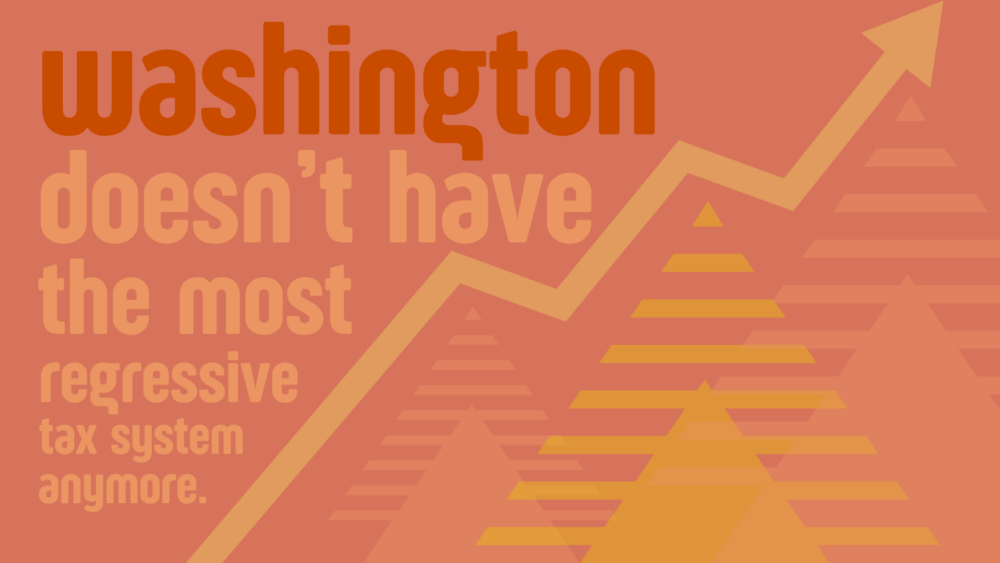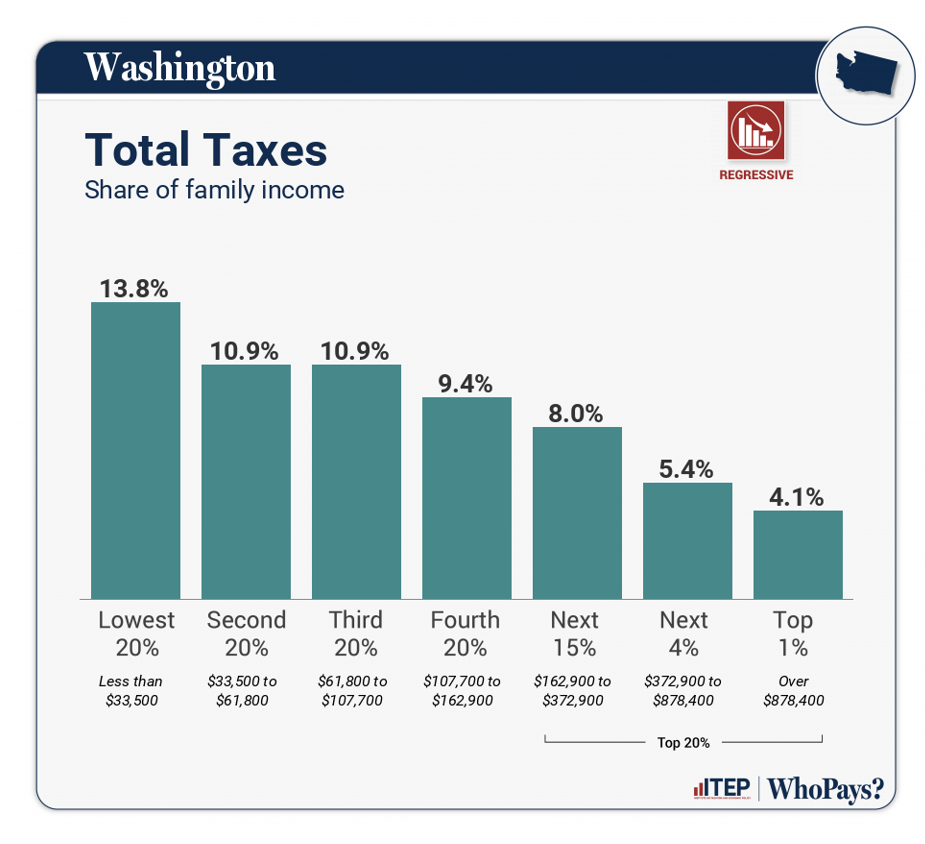
For decades, Washington State has held the distinct dishonor of having the most regressive tax structure in the nation. The ultra-wealthy pay just a fraction of their ample income, while regular people pay a higher percentage of their earnings.
In fact, lawmakers and advocates looking to make changes to the way we collect revenue – like those supporting a new tax on the ultra-wealthy – frequently cite the objective fact that the lowest earners shoulder a disproportionate burden in Washington.
In this year’s legislative session, though, the people testifying in hearings will be adding a caveat to their statements. Because, for the first time since this report has been released, Washington is no longer at the bottom of the pack.
Instead, it’s now ranked number 49 out of 50.
Who decides which states have the most regressive system?
Since 1996, the Institute on Tax and Economic Policy (ITEP) has collected data to form a state-by-state analysis of tax structures. These findings are published in a report entitled “Who Pays?” Earlier this month, ITEP released the seventh edition of this report.
In the updated report, Washington has, for the first time, moved from its position in dead last. The state now sits at number 49, trailed by a small margin by Florida.
This should be cause for celebration. Washington’s upside-down tax code means the state is often short on revenue and unable to invest in the services that the communities need. This position change, then, means that some of the new policies enacted in the last few years have had a real impact on the lives of Washington residents. It also means that the state might be collecting more revenue and, possibly, filling in gaps in funding to areas like education.
But there’s more to this story, too. We have to ask ourselves: Have Washington’s taxes become demonstrably more equitable? Or is it simply a race to the bottom? With states like Florida providing even more tax breaks to billionaires, did Washington really improve, or was it a draw?
How can Washington and Florida – two states with starkly different leadership, voting populations, and economies – be so close when it comes to how they collect revenue?
The answer lies in a little bit of both.
Why are Washington’s taxes so unfair?
It’s important to remember that tax structures are not inevitable. They’re not handed down from a higher power or harvested from the earth. Every state’s tax system is built from hundreds, if not thousands, of policy decisions, some big and some small. All of these little choices contribute to who pays taxes and how much.
The origin of Washington’s unfair tax structure is not a mystery. We know exactly why it’s unfair and what can be done to change it. It’s just a matter of getting it done – which has historically been a struggle. But the new ranking helps to demonstrate that making progressive and bold changes actually does move the needle.
As reported in ITEP’s report, Washington is a tax haven for the wealthy. It’s also a high-tax state for low-income people. For example, the poorest quintile pay 13.8 percent of their household income per year in state and local taxes while the richest 1 percent (those making more than $848,400 per year) pay just 4.1 percent.
As a result, Washington is often short on revenue and unable to invest in the services that the communities need. At the same time, more residents might find themselves in need of services, like food assistance or housing vouchers, because they don’t earn enough to get by.

What regressive taxes mean in practice
There are several concrete reasons why Washington’s tax structure favors the wealthy. Between a lack of statewide income tax, carve-outs for corporations, and high city and sales taxes, everyday folks simply end up paying more of their income back into taxes.
Low-income (and due to the cost of living, increasingly more middle-income) people are generally not able to save much of their income. As a result, they’re unable to invest in real estate, mutual funds, or other investment vehicles. Rather than saving their dollars, low-income people end up spending most of their hard-earned money. And because consumer activity is taxed at about 10% via the state and local sales taxes, lower-income folks end up paying more of their income into those taxes.
Furthermore, for both low- and middle-income households, wealth is typically tied up in the home equity. In Washington, homes are taxed annually at about 1% of their assessed value whether they’re sold or not. The property tax, while slightly less regressive than the sales tax, also contributes to Washington’s regressive tax code.
A rich deal for the rich
In contrast, high income earners can save their money rather than spend most of it. These savings are invested into real-estate, retirement accounts, and most importantly, the stock market; these investments accrue value, and if sold, can earn money for already wealthy individuals without them having to clock in to work.
While the wealthy own real estate, most of their wealth is tied up in corporate equity like stocks in tech companies. In spite of popular misconceptions, Washington is a tax haven for the wealthy. That’s because high incomes are not taxed and, importantly, money generated on financial assets like Wall Street stocks and mutual funds are not taxed unless they are sold.
So if Washington used to be ranked last in the tax fairness line up, what happened to make this change? Why are we now 49th? To find the answer, we have to look at two recently-passed changes to our tax structure.
Surprise! Progressive taxes make the system more progressive.
Together, two primary policies have helped bring Washington closer to equity. The capital gains tax and the Working Families Tax Credit (WFTC) both played a big role in the change; one helps those who earn the least, while another increased taxes on those who have the most.
ITEP estimates that the WFTC decreased the lowest income quintile’s taxes as measured by percent yearly income by about 1.4 percent. Additionally, they estimate that capital gains tax increased taxes on the top 1 percent by 0.7 percent. These movements together helped balance the tax code.
The capital gains tax represents a monumental change to the tax base and one that advocates and lawmakers had been pursuing for decades. Not only has it brought in more revenue than anyone anticipated, but it’s also helped lay the groundwork for future changes. At the same time, the WFTC is already reaching hundreds of thousands of people across the state. This puts actual money in the pockets of actual Washington residents.
But even these huge changes could only garner Washington one single spot on the list.
The scope of the change matters. It outlines the size and scale of the additional improvements that we need to make. It also demonstrates the benefit that big changes can have on the overall taxation structure.
A race to the bottom
Further, Washington’s movement on the ITEP list highlights the need to protect any and all progress on fixing our tax structure. We can’t take for granted improvements like the WFTC or the capital gains tax – especially in the face of opposition.
There are plenty of people in Washington State who seem more than content to hold firmly to this unfair tax system. Specifically, ultra-wealthy people who want to keep their money at all costs and have convinced regular, non-billionaires that they’ll somehow benefit, too, by rolling back reforms and maintaining a system that benefits the wealthy at everyone else’s expense.
At the same time, these individuals are feeling the pinch of such an unfair system. Many of them might even be eligible for the WFTC, but have no idea they’re entitled to assistance. Instead, they clamor for lower taxes across the board – without concern for the many programs and services they, themselves, use.
Washington’s regressive taxes mean that the state isn’t collecting enough revenue for all of the programs we need, including housing, schools, roads, and mental health care and substance use treatment. Under this situation, everyone loses.
But there are solutions available. A state wealth tax, being considered by the state legislature now, would close that glaring loophole in our tax code by taxing financial property of multi-millionaires and billionaires in the same way our homes are taxed. More than 99% of the state’s residents wouldn’t pay a dime under this new tax which would generate millions of dollars for the state.
Tax policy at the ballot
At the same time, lawmakers are faced with a slate of right-wing legislative initiatives from a campaign called “Let’s Go Washington.” Funded almost entirely by conservative millionaire and Trump donor Brian Heywood, these initiatives are dangerous for our state.
The bundle of initiative includes one to repeal the capital gains tax, as well as one that would ban an income tax. If passed, the latter could have far-reaching impacts, including getting rid of the state’s hard-won and much loved benefits of Paid Family and Medical Leave.
At least one initiative, which would roll back the capital gains tax, has also officially qualified for the ballot. We can expect a firehose of propaganda in the coming months – and it’s going to be critical that we correct the record.
The people want better
While right wing millionaires can buy their issues onto the ballot, poll after poll (and common sense) shows that Washingtonians are hungry for change. Not only do most voters dislike the current regressive tax system, they also think the wealthy should pay more. Finally, polling has shown that Washington residents enjoy the programs and services that taxes fund and would like to see them fully funded rather than subjected to cuts and austerity.
And the outlook shows that digging us deeper into a regressive tax system and further exacerbating austerity budgets will only worsen quality of life in Washington. Schools need climate control to deal with the impacts of hotter summers and colder winters. Residents, especially seniors, are still experiencing higher-than-average rates of poverty following COVID-19. Our infrastructure is not prepared for future disasters.
There is simply not enough revenue in Washington to maintain the services that residents need, and certainly not enough to improve our quality of life.
The new ITEP report makes it clear: In order to become a less regressive state, we need to pass policies which benefit regular working people. We need to stop giving handouts and corporate welfare to those who earn the most. And Washington’s hundred or so billionaires must be required to pay into the tax base at the same rate as everyone else.
The state’s most marginalized have borne the burden for too many years.
More To Read
March 20, 2024
I-2111: The Income Tax Ban Is A Spectacle, but One We Can’t Ignore
A way to waste time, energy, and money, I-2111 is costing more than just taxes
February 2, 2024
What is REET and Why Do We Need to Reform It?
Washington State lawmakers have the chance to make a progressive tax more progressive and provide a permanent funding source for affordable housing
January 23, 2024
Report: Washington no longer has the most regressive tax structure in the nation
This is both cause for celebration and a call to action
